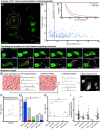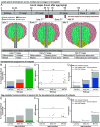Formation of recurring transient Ca2+-based intercellular communities during Drosophila hematopoiesis
- PMID: 38602917
- PMCID: PMC11032476
- DOI: 10.1073/pnas.2318155121
Formation of recurring transient Ca2+-based intercellular communities during Drosophila hematopoiesis
Abstract
Tissue development occurs through a complex interplay between many individual cells. Yet, the fundamental question of how collective tissue behavior emerges from heterogeneous and noisy information processing and transfer at the single-cell level remains unknown. Here, we reveal that tissue scale signaling regulation can arise from local gap-junction mediated cell-cell signaling through the spatiotemporal establishment of an intermediate-scale of transient multicellular communication communities over the course of tissue development. We demonstrated this intermediate scale of emergent signaling using Ca2+ signaling in the intact, ex vivo cultured, live developing Drosophila hematopoietic organ, the lymph gland. Recurrent activation of these transient signaling communities defined self-organized signaling "hotspots" that gradually formed over the course of larva development. These hotspots receive and transmit information to facilitate repetitive interactions with nonhotspot neighbors. Overall, this work bridges the scales between single-cell and emergent group behavior providing key mechanistic insight into how cells establish tissue-scale communication networks.
Keywords: Drosophila hematopoiesis; calcium signaling; cell–cell communication; multicellular synchronization; quantitative live imaging.
Conflict of interest statement
Competing interests statement:The authors declare no competing interest.
Figures



Similar articles
-
A gap-junction-mediated, calcium-signaling network controls blood progenitor fate decisions in hematopoiesis.Curr Biol. 2021 Nov 8;31(21):4697-4712.e6. doi: 10.1016/j.cub.2021.08.027. Epub 2021 Sep 3. Curr Biol. 2021. PMID: 34480855
-
Septate junction components control Drosophila hematopoiesis through the Hippo pathway.Development. 2019 Apr 4;146(7):dev166819. doi: 10.1242/dev.166819. Development. 2019. PMID: 30890573
-
Drosophila as a Model to Study Cellular Communication Between the Hematopoietic Niche and Blood Progenitors Under Homeostatic Conditions and in Response to an Immune Stress.Front Immunol. 2021 Aug 16;12:719349. doi: 10.3389/fimmu.2021.719349. eCollection 2021. Front Immunol. 2021. PMID: 34484226 Free PMC article. Review.
-
The TEAD family transcription factor Scalloped regulates blood progenitor maintenance and proliferation in Drosophila through PDGF/VEGFR receptor (Pvr) signaling.Dev Biol. 2017 May 1;425(1):21-32. doi: 10.1016/j.ydbio.2017.03.016. Epub 2017 Mar 18. Dev Biol. 2017. PMID: 28322737
-
The Drosophila lymph gland is an ideal model for studying hematopoiesis.Dev Comp Immunol. 2018 Jun;83:60-69. doi: 10.1016/j.dci.2017.11.017. Epub 2017 Nov 27. Dev Comp Immunol. 2018. PMID: 29191551 Review.
Cited by
-
Quantification of collective signalling in time-lapse microscopy images.Methods Microsc. 2024 Jun 19;1(1):19-30. doi: 10.1515/mim-2024-0003. eCollection 2024 Apr. Methods Microsc. 2024. PMID: 39119253 Free PMC article.
References
-
- Julicher F., Eaton S., Emergence of tissue shape changes from collective cell behaviours. Semin. Cell Dev. Biol. 67, 103–112 (2017). - PubMed
-
- Mayor R., Etienne-Manneville S., The front and rear of collective cell migration. Nat. Rev. Mol. Cell Biol. 17, 97–109 (2016). - PubMed
-
- Bassler B. L., How bacteria talk to each other: Regulation of gene expression by quorum sensing. Curr. Opin. Microbiol. 2, 582–587 (1999). - PubMed
-
- Capuana L., Bostrom A., Etienne-Manneville S., Multicellular scale front-to-rear polarity in collective migration. Curr. Opin. Cell Biol. 62, 114–122 (2020). - PubMed
MeSH terms
Substances
Grants and funding
LinkOut - more resources
Full Text Sources
Molecular Biology Databases
Miscellaneous

